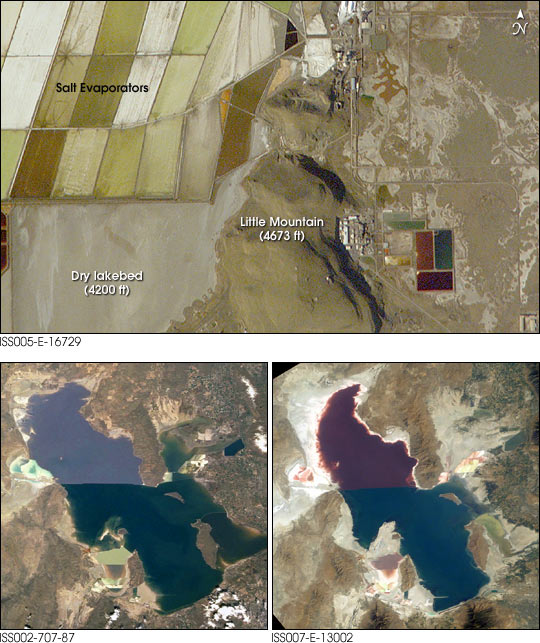


Great Salt Lake serves as a striking visual marker for astronauts orbiting over North America. A sharp line across its center is caused by the restriction in water flow from the railroad causeway. The eye-catching colors of the lake stem from the fact that Great Salt Lake is hypersaline, typically 3-5 times saltier than the ocean, and the high salinities support sets of plants and animals that affect the light-absorbing qualities of the water. North of the causeway salinities are higher, and the water turns red from the pigments of halophilic bacteria. In the shallower corners of the lake, earthen dikes mark large salt evaporation works, which take on the jewel tones of turquoise, russet, amber, and pearl white.
The detailed image shows some of the salt works operated by Great Salt Lake Minerals and Chemicals Corporation near West Warren, Utah, on the eastern shore of the lake. Evaporative salt harvesting at Great Salt Lake is an important source of minerals for industrial uses. The lake contains an estimated 5 billion tons of salt, with 2.5 million additional tons washing in each year. Extraction rates are slightly higher than the amount added to the lake each year. In addition to sodium chloride, the ponds near West Warren are used to extract potassium sulfate and magnesium chloride, which are used to make fertilizers.
Space Station astronauts have recorded the decline in lake levels in response to a regional 5-year drought taking both detailed views and broad views of the entire lake. As lake levels have declined the salt works have become islands in the middle of a dry lakebed. Seasonal fluctuations in Great Salt Lake produce annual lows every fall, but there are significant longer-term fluctuations in lake levels relating to the climate. Great Salt Lake hit a 22-year low at 4,198 feet in the fall of 2002, and a near-record low again in October 2003. The lowest level ever recorded was 4,191 feet in 1963, and the highest levels were 4,212 feet in June 1986 and April 1987. Experimental scientific forecasts predict that lake levels will begin gradually increasing again, but the U.S. Seasonal Drought Outlook indicates only limited improvement from this snow season because the water deficits are so high.
Around the world, lake levels are an excellent indicator of local climate. Repeat observations over time allow comparisons and levels rise and fall in response to droughts and the broader climate patterns that are linked to droughts.
Less-detailed images of the decline in the Great Salt Lake as seen from Terra satellite’s Moderate Resolution Imaging Spectroradiometer (MODIS) sensor were previously shown on Earth Observatory. MODIS has also documented dust storms related to the drought.
Space Station images of Salt Lake City were also previously featured on Earth Observatory.
Three different space station crewmembers took the photographs shown above. Image ISS005-E-16729 was taken with a Kodak DCS760 digital camera and 800-mm lens on October 7, 2002, ISS007-E-13002 was taken with a digital camera and 50-mm lens on August 19, 2003, ISS002-707-87, was taken with a Hasselblad film camera and 110-mm lens in summer 2001. Details provided by Julie Robinson (Lockheed Martin), Earth Observations Laboratory, Johnson Space Center. The International Space Station Program supports the laboratory to help astronauts take pictures of Earth that will be of the greatest value to scientists and the public, and to make those images freely available on the Internet. Additional images taken by astronauts and cosmonauts can be viewed at the NASA/JSC Gateway to Astronaut Photography of Earth.